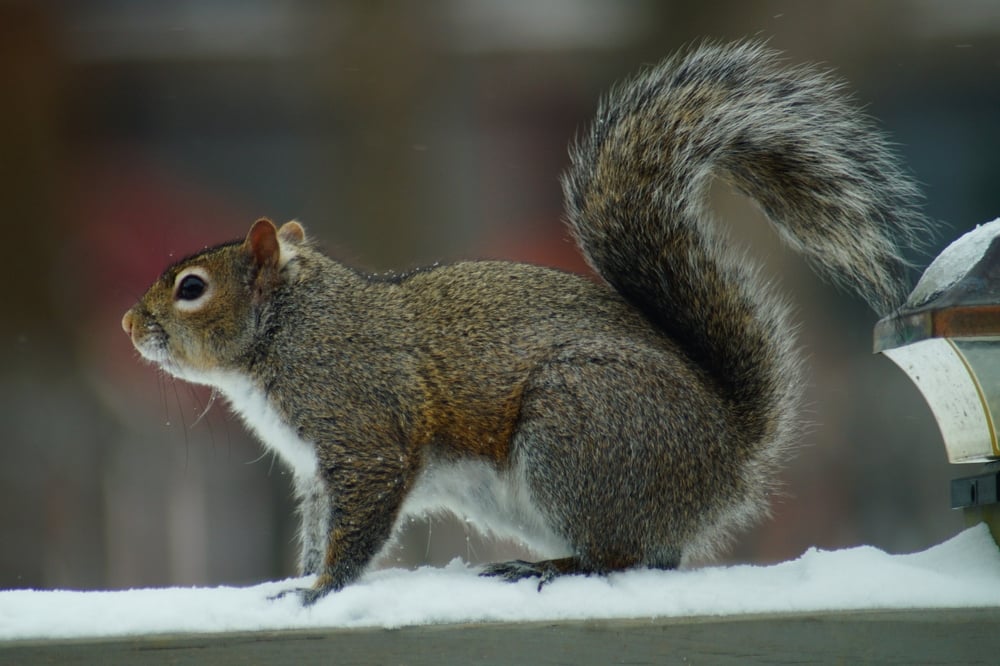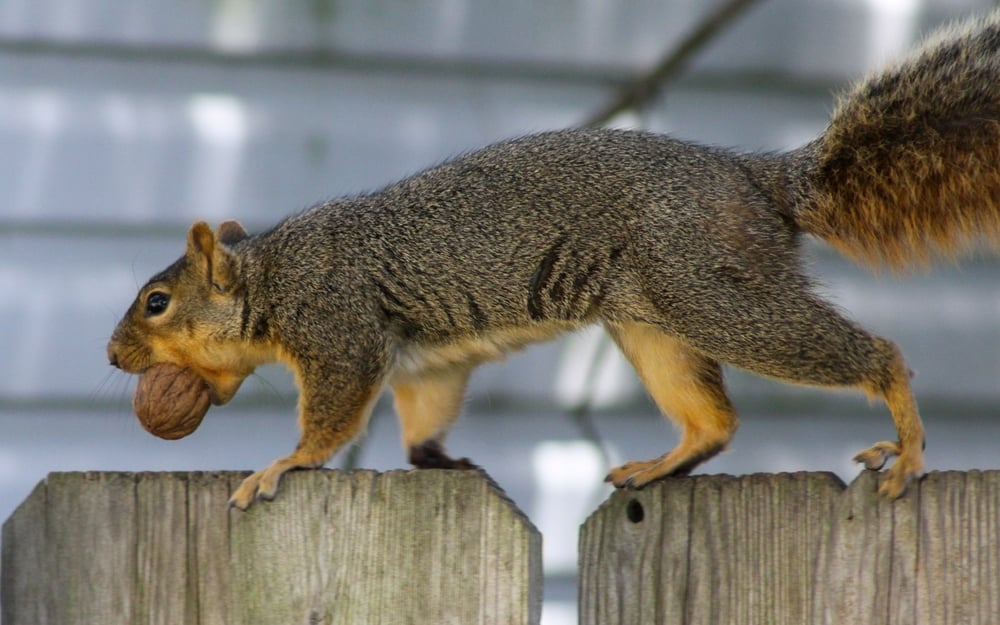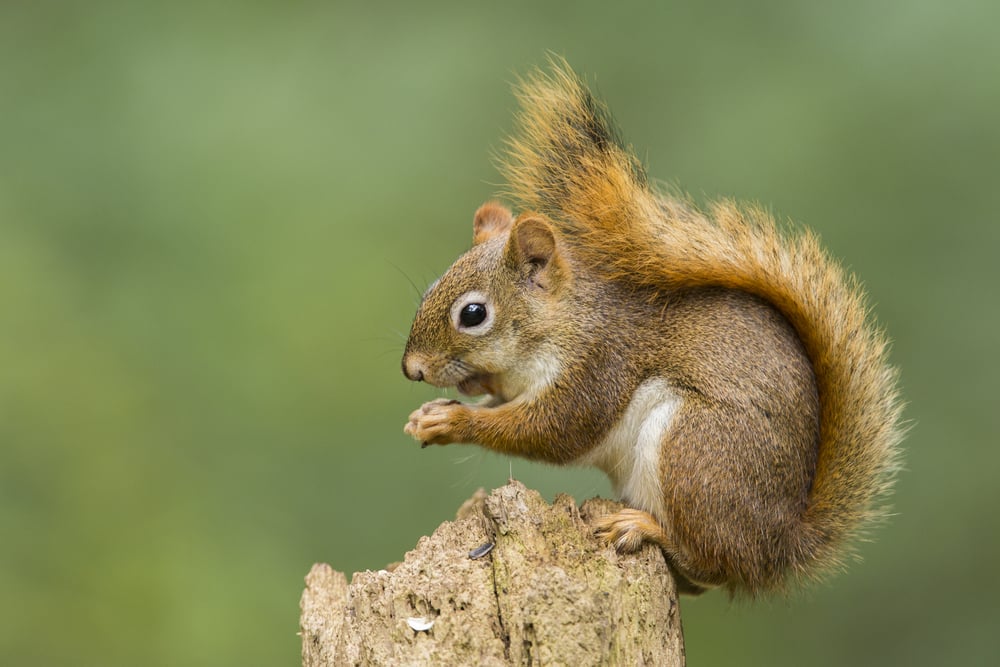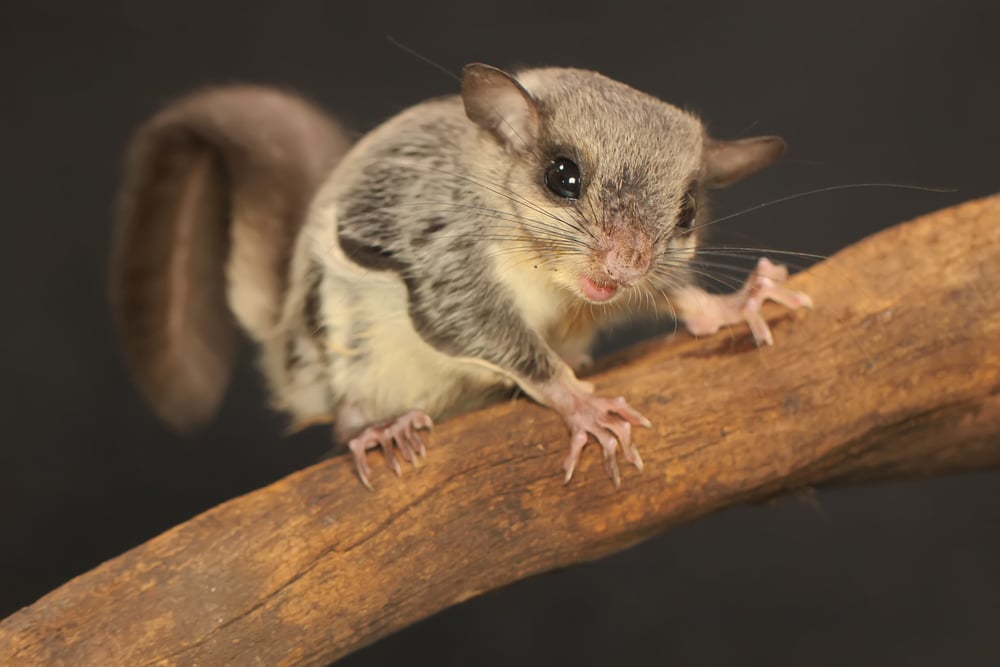Do you want to learn about the different types of Squirrels in Connecticut?
Finding information about Squirrels in Connecticut was not as easy as I thought. Some sites were not comprehensive enough, others were incorrect, and some didn’t provide relevant information about squirrels that live in Connecticut!
That is why I created this post about the 4 Common Types of Squirrels in Connecticut.
In this post, you will learn about the common types of squirrels in Connecticut, their behavior, and the role they play in their ecosystems.
4 Types of Squirrels in Connecticut
#1. Eastern Gray Squirrel (Sciurus carolinensis)

Identifying Characteristics and Facts
- Grayish body with brown or white fur and a whitish belly.
- About 20 inches in length with a tail of about 150 – 250 mm.
- Weighs about 1.5 pounds.
- Primarily eat nuts and also eat fruits, flowers, and bulbs.
- They also feed on frogs, insects, farm crops, and bird eggs.
- Male ones are usually polygamous.
If you are a resident of Connecticut, you must have come across or seen this awesome creature. This squirrel dwells on trees and is widely recognized not only in Connecticut but also in other parts of the world.
Not only that, but it is also one of the easiest to identify squirrel species. As you can guess by its name it is grayish, but some types of the Eastern Gray Squirrel may have some black, brown, or white fur. It also has a bushy tail and the belly is also whitish.
Size and weight
The Eastern Gray Squirrel can be comparable in size and weight to that of a large rat. The body length is about 16 – 20 inches with a long and bushy tail that is about 150 – 250 mm in length. Not only this, but the eastern gray squirrel is about 1.5 pounds.
Behavior and Diet
One of the interesting facts about the eastern gray squirrel is their all-year activeness. They are one of the most active creatures during the daytime.
During winter or when it snows, you will see them digging to retrieve the food that they usually store or bury in caches. Based on this information, it should be noted that they do not hibernate during the winter period.
These squirrels primarily eat nuts and acorns that they obtain from beech, oak, and walnut among other trees. Not only that, but they also eat fruits, flowers, and bulbs among other food materials from plants.
Habitat, communication, and Reproduction
These types of squirrels in Connecticut inhabit dense woodland ecosystems. You will see them in forests that have trees that bear the nuts they feed on, generally mixed hardwood forests.
When it comes to communication, the noises they make and the postures they have are their primary way. They also use scent markings by rubbing their bodies against some trees.
It is also important to know something about their reproduction. One interesting fact about these species of squirrels is that the males are always polygamous. That means one male can make with several other females and they bear 2 – 6 offspring after a gestation period of 40 – 45 days.
#2. Fox Squirrel (Sciurus niger)

Identifying Characteristics and Facts
- Reddish-yellow belly with gray mix.
- The fringe of the tail is also reddish-brown.
- About 20 – 30 inches of body length.
- Weigh in between 1.5 – 4.0 lbs.
- The tail size measures 8 – 10 inches long.
- Males are usually larger in size compared to females.
If you are beginning to learn about squirrels, you may think a fox squirrel is similar to others, but that is far from the truth.
What’s the difference between a fox squirrel and a regular squirrel?
It is very easy to confuse the fox squirrel and the regular squirrel when looking at just their physical appearance.
You will notice that the fox squirrel is heavy-bodied. That means it is larger in body size than the regular squirrel. When it comes to color, they have reddish-yellow bellies with gray mixes. The fringe of the tail is also reddish-brown.
Size and weight
When it comes to size, fox squirrels are considered medium. You will find them with sizes ranging from 20 – 30 inches long. The tail size measures 8 – 10 inches long, and the weight is between 1.5 – 4.0 lbs.
It is also important to understand that male squirrels are usually larger in size compared to their female counterparts.
Behavior and Diet
When it comes to behavior, the fox squirrel is a solitary animal. They usually don’t stay in groups but they can congregate when they are feeding.
A typical day for a fox squirrel is full of activities that include eating its food and gathering and storing more for the off-peak and winter season.
Since their day is consumed with eating and storing, their food comprises fruits, nuts, buds, insects, amphibians, and even the bark of some trees.
Habitat, communication, and Reproduction
The only way to spot these amazing creatures is to know where they live. In Connecticut and many parts of the world, you will spot them in open or savanna-like habitats. They usually like staying in areas where trees are well-spaced.
Of course, areas with trees that feed on their fruits or nuts are also their preferred habitats. This includes oak and hickory forests among other places like pine forests and mangrove swamps.
Ecological importance and challenges
The Fox Squirrel (Sciurus niger) faces numerous challenges that include but are not limited to habitat loss and fragmentation, predation, diseases, and competition from the other types of squirrels.
#3. American Red Squirrel (Tamiasciurus hudsonicus)

Identifying Characteristics and Facts
- About 12 inches in body length with a tail size of about 5 – 7 inches.
- They have a weight of about 200 – 250 grams.
- Feed on cones and seeds of some evergreen trees.
- They also eat berries and fruits when in season, and bird eggs.
- Territorial and they thus defend the territories they mark with their scent glands.
- They also hoard food so they can eat during winter.
- Highly vocal, noisy, and most active during the daytime.
- Solitary but can stay in groups during mating.
Size and weight
The American Red Squirrel is a small species and weighs about 200 – 250 grams. They are also about 12 inches in body length and also have a long tail size of about 5 – 7 inches.
Behavior and Diet
The diet is another feature that defines this type of squirrel. It is in what they eat that you will know whether they are destructive or not. The American Red Squirrel usually eats the cones and seeds of evergreen trees and is also known to eat the eggs of some birds, berries, and fruits during their seasons.
When it comes to their behavior, these squirrels are territorial and they usually mark their territories using their scent glands. After marking, they then defend these territories from invasion by other squirrels.
Another characteristic that marks their behavior is their solitary nature. They are always solitary creatures except when looking after the young ones. You will also see them in groups when they are mating.
In addition to their behavior, they are also hoarders. They collect and hoard food in caches in preparation for the winter season. They are also very vocal, noisy, and active mostly during the day.
Habitat, communication, and Reproduction
Due to their diet, these squirrels live mostly in coniferous forests. They prefer these habitats with dense canopies because it is where they find their food. The dense canopies also help them hide from predators.
Regarding communication, these creatures communicate using various means such as territorial calls, social calls, mating calls, and alarm calls. These calls differ so that they can serve the particular reason they want to communicate with others.
When it comes to reproduction, these squirrels have a season of reproduction running from February to June. During mating, the males usually compete for the females and when they mate, the females give birth to about 2 – 8 young ones after a gestation period of about 35 days.
Ecological importance and challenges
The American Red Squirrel faces numerous challenges of habitat loss, climate change, and competition from other squirrels for food.
They play a great ecological importance such as helping in seed dispersal, in pollination of plants such as the fir trees, and in being food to other animals in the food chain.
#4. Southern Flying Squirrel (Glaucomys Volans)

Identifying Characteristics and Facts
- About 8 – 10 inches in body length including the tail and weighs between 1.6 – 2.5 ounces.
- Nocturnal and mostly active during night hours.
- Always solitary but can stay in family groups.
- Usually come together during winter for communal nesting.
- Eats berries, fruits, seeds, nuts, insects, carrion, and bird eggs.
- Prefers habitats with large hickory trees and beech trees be it deciduous or mixed forests.
- Communicate by vocalizations, body language, and scent markings.
- Usually breed once or twice a year.
Size and weight
These squirrels are small in size and they are only about 8 to 10 inches in the body length. This comprises the whole body plus the tail. In terms of weight, they usually weigh between 1.6 – 2.5 ounces.
It is important to note that the southern flying squirrel is one of the common types of squirrels in Connecticut, but they are also common in other regions of the world.
Behavior and Diet
When it comes to behavior, there are so many things that we can say about the Southern Flying Squirrel. This squirrel is solitary in nature which they are well-known for. They are not completely solitary since they can live in groups comprising of family members, and also form colonies or communal nests during the winter season.
Perhaps the communal nesting is to offer them the warmth they need to go through the cold season. These squirrels eat numerous food types including berries, fruits, nuts, seeds, carrion, and even insects and bird eggs.
Habitat, communication, and Reproduction
The habitat of these squirrels varies but mostly in deciduous or mixed forests with dense vegetation, hickory trees, and beech trees. This is because of their diet where in these habitats, they can find them easily. In addition to that, the dense vegetation also helps them hide from predators.
Southern flying squirrels have varied ways of communicating. That could be through vocalizations such as whistles and chirping, and through scent markings, and body language such as tail wagging. Males use these communications to attract females for mating and reproduction.
Ecological importance and challenges
There are a lot of challenges that these squirrels face in their habitats. The loss of their habitats, competition, and predation are some of the few challenges that these Southern flying squirrels face.
Apart from the challenges, they play a lot in their ecological habitats such as in promoting seed dispersal, fungi consumption, and controlling the populations of insects.
As a reminder, the below factors are common for the most common squirrels in Connecticut:
- Size and weight a common ways to identify squirrels
- Behavior and Diet is a way to determine how destructive the squirrel will be
- Habitat, communication, and reproduction are interesting factors about squirrels
- All of these squirrels face numerous ecological challenges
If you want to learn how to Keep Squirrels Out of Your Garden then check out THIS ARTICLE.